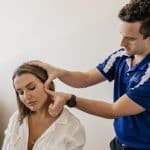Instrument Assisted Soft Tissue Mobilisation (IASTM) using RockBlades

Some people develop back and neck pain because certain muscles groups are weak. Rockblades can help to reduce the tightness in the fascia that the person suffering from the pain might be feeling because their postural muscles are weak.
After doing this we can then train the postural muscles to work better and therefore reduce the problem of the fascia supporting the posture instead of the muscles.
Instrument assisted soft tissue mobilisation is used extensively with sporting teams in the United States and has been for over 15 years. The Rockblade itself was designed in conjunction with a group of medical scientists and engineers. They were curious as to how these adhesions form in the fascial tissue that covers the muscles.
It is known that no amount of muscle stretching or massage will reduce adhesions in the fascia that often are the cause of pain in the body. Headaches especially, if as a result of adhesions in the fascia, can even sometimes cause disturbances in vision and balance.
Other people with hypermobility issues can find relief with pain when treated using Instrument Assisted Soft Tissue Mobilisation (IASTM) or fascial release as often they have tension and adhesions in their fascia that can lead to subluxation and dislocation of joints.
It is very important if you have hypermobility issues and you are treated with a form of soft tissue release, that you also do an exercise program that will correct alignment and support the area that has been worked on.
Sometimes after treatments using IASTM tools such as the Rockblade, it may be necessary to use a form of kinesiology taping to support the area after treatment.


